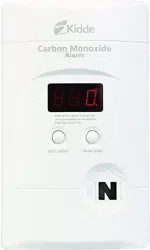Loading ...
Loading ...
Loading ...

7. Maintenance
• Do not paint the unit. Paint will seal the vents and interfere with proper
sensor operation.
Move the CO Alarm to a remote location, to prevent possible damage or
contamination of the sensor, prior to performing any of the following:
• Staining or stripping floors or furniture, painting or wall-papering
• Using aerosols or adhesives
WARNING: Reinstall the CO Alarm as soon as possible to assure
continuous protection.
The following is a list of substances that at high levels can damage the
sensor or cause temporary readings that are not CO readings:
• Ethylene, ethanol, alcohol, iso-propanol, benzene, toluene, ethyl
acetate, hydrogen, hydrogen sulfide and sulfur dioxide.
• Also most aerosol sprays, alcohol based products, paint, thinner, sol-
vent, adhesive, hair spray, after shave, perfume, auto exhaust (cold
start) and some cleaning agents.
End of Life Notification
Ten (10) years after unit is first powered, this alarm will beep two times
every 30 seconds to indicate it is time to replace the alarm, and “End”
will show in the digital display. Once the unit is in End of Life
Notification mode, the alarm will no longer detect the presence of CO.
FCC COMPLIANCE STATEMENT
This equipment has been tested and found to comply with the limits for
a Class B digital device, pursuant to part 15 of the FCC Rules.
These limits are designed to provide reasonable protection against harm-
ful interference in a residential installation. This equipment generates,
uses and can radiate radio frequency energy and, if not installed and
used in accordance with the instructions, may cause harmful interference
to radio communications. However, there is no guarantee that
interference will not occur in a particular installation. If this equipment
does cause harmful interference to radio or television reception, which
can be determined by turning the equipment off and on, the user is
encouraged to try to correct the interference by one or more of the
following measures:
—Reorient or relocate the receiving antenna.
—Increase the separation between the equipment and receiver.
—Connect the equipment into an outlet on a circuit different from that
to which the receiver is connected.
—Consult the dealer or an experienced radio/TV technician for help
!
2507-7229-01(820-1388_RevC).qxd:_ 2013.4.1 12:25 PM P
Loading ...
